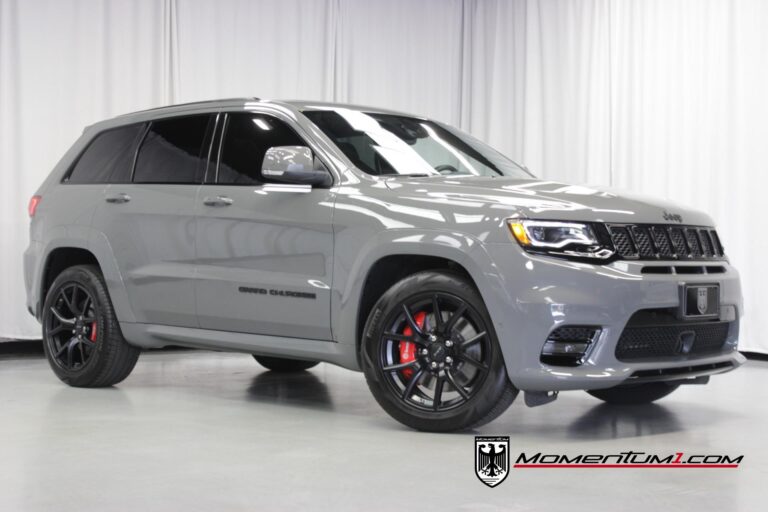Top Speed Of Jeep Grand Cherokee Trackhawk
Top Speed Of Jeep Grand Cherokee Trackhawk jeeps.truckstrend.com
An Engaging Introduction: Unleashing the Beast
In the realm of high-performance vehicles, certain machines defy convention, pushing the boundaries of what’s expected from their class. The Jeep Grand Cherokee Trackhawk is undeniably one such icon. At first glance, it’s a quintessential American SUV: robust, spacious, and inherently practical. However, beneath its muscular exterior lies a monstrous heart – the supercharged 6.2-liter HEMI V8 engine, famously known as the Hellcat. This powertrain transforms the family-friendly Grand Cherokee into a pavement-shredding, adrenaline-pumping beast capable of astonishing feats, chief among them its breathtaking top speed.
Top Speed Of Jeep Grand Cherokee Trackhawk
The very concept of an SUV reaching speeds typically reserved for exotic sports cars is what makes the Trackhawk so captivating. Its official, electronically limited top speed stands at an astounding 180 miles per hour (290 kilometers per hour). This figure isn’t just a number; it represents a triumph of engineering, a bold statement from Jeep, and a testament to the raw power and sophisticated mechanics packed into this extraordinary utility vehicle. For enthusiasts and casual observers alike, understanding how an SUV achieves such velocity, and what that experience entails, is key to appreciating the legend of the Jeep Grand Cherokee Trackhawk.
The Heart of the Beast: The Supercharged Hellcat Engine
The genesis of the Trackhawk’s phenomenal top speed lies squarely in its powertrain: the legendary 6.2-liter Supercharged HEMI V8 engine. This isn’t just any V8; it’s the very same Hellcat engine that powered Dodge’s Challenger and Charger into the annals of muscle car history.
Producing a staggering 707 horsepower and 645 lb-ft of torque, this engine is a marvel of modern automotive engineering. The key to its immense power output is the massive 2.4-liter twin-screw supercharger mounted atop the engine. This supercharger force-feeds air into the combustion chambers at a rapid rate, effectively cramming more oxygen and fuel into each cylinder, resulting in a significantly more powerful explosion with every ignition cycle. The distinctive whine of the supercharger is a signature sound of the Trackhawk, a prelude to the violent acceleration it’s capable of.
This immense power is not merely for show; it’s precisely what’s needed to propel a vehicle weighing over 5,300 pounds to such incredible speeds. The engine’s robust construction, including a forged steel crankshaft, high-strength forged alloy pistons, and heat-treated aluminum cylinder heads, ensures it can withstand the extreme pressures and temperatures generated during peak performance. Without this powerhouse, the Trackhawk’s top speed would remain an impossible dream for an SUV of its stature.
Engineering for Extreme Velocity: Beyond Just Horsepower
While the Hellcat engine is the undisputed star, achieving and maintaining a top speed of 180 mph requires far more than just raw horsepower. The entire vehicle’s architecture and componentry must be meticulously engineered to handle such extreme forces.
- Robust Drivetrain: The Trackhawk utilizes an incredibly robust ZF 8HP95 8-speed automatic transmission, specifically calibrated for high-performance applications. This transmission is designed to withstand the Hellcat’s immense torque, ensuring efficient and rapid power delivery to all four wheels. It features various drive modes, including Track, Sport, and Tow, each adjusting shift points, throttle response, and suspension settings to optimize performance for different scenarios.
- Advanced All-Wheel Drive (AWD) System: The Quadra-Trac® Active On-Demand 4×4 system is crucial for harnessing the Trackhawk’s power. Unlike traditional SUVs, this system is heavily performance-tuned, capable of sending up to 70% of the torque to the rear wheels in Track mode, mimicking a rear-wheel-drive feel for optimal acceleration and high-speed stability. This system ensures maximum traction under aggressive acceleration, minimizing wheel slip and efficiently translating power into forward motion.
- Performance Suspension: To maintain stability at high speeds, the Trackhawk is equipped with an adaptive damping suspension system featuring Bilstein adaptive shock absorbers. This system continuously adjusts damping forces based on road conditions, driver input, and selected drive mode, ensuring the vehicle remains composed and stable even when pushing the limits of its performance envelope. The lower ride height and stiffer springs also contribute to reduced body roll and improved handling dynamics at speed.
- High-Performance Braking System: Stopping a 5,300-pound SUV from 180 mph requires equally impressive braking power. The Trackhawk boasts a massive Brembo high-performance braking system with two-piece vented rotors (15.75 inches at the front, 13.78 inches at the rear) and six-piston calipers at the front. This system provides exceptional stopping power, fade resistance, and pedal feel, crucial for safety and confidence during high-speed maneuvers or track use.
- Aerodynamics and Stability: While the Grand Cherokee’s fundamental SUV shape isn’t inherently aerodynamic like a supercar, Jeep engineers made crucial modifications. The Trackhawk features specific aerodynamic enhancements, including a unique front fascia designed to optimize airflow for cooling and reduce lift, a revised hood with functional heat extractors, and a rear spoiler. These elements contribute to improved high-speed stability, helping to keep the vehicle planted and predictable as it approaches its top speed.


What 180 MPH Feels Like in an SUV
Experiencing 180 mph in a Jeep Grand Cherokee Trackhawk is a sensation unlike almost anything else on four wheels. Unlike the low-slung, often cramped cabins of dedicated sports cars, the Trackhawk offers a commanding, elevated driving position.
As the supercharger whines to a crescendo and the speedometer needle climbs past figures typically seen only in aircraft, the cabin, remarkably, remains relatively serene. The extensive sound insulation and solid build quality work to filter out much of the wind noise, leaving primarily the glorious roar of the Hellcat engine and the subtle hum of the drivetrain.
The vehicle feels incredibly stable for an SUV. The adaptive suspension stiffens, the steering becomes heavier and more precise, and the AWD system ensures that power is distributed effectively, minimizing any sense of twitchiness. There’s a surreal feeling of immense power pushing you forward, combined with the reassuring sensation of control. The road ahead blurs, objects whiz by at an alarming rate, and the world outside becomes a streaky canvas. It’s a unique blend of supercar performance with the comfortable, upright ergonomics of a Grand Cherokee, a truly exhilarating and somewhat disorienting experience that underscores the Trackhawk’s engineering prowess.
Factors Influencing Top Speed Attainment
While the Trackhawk is rated for 180 mph, achieving this exact figure consistently depends on several critical factors:
- Environmental Conditions:
- Air Density: Higher altitudes mean thinner air, which reduces air resistance but also slightly diminishes engine power. Lower temperatures increase air density, aiding aerodynamics but also requiring the engine to work harder against denser air.
- Wind Resistance: A strong headwind can significantly reduce top speed, while a tailwind can offer a slight boost.
- Vehicle Condition:
- Tires: Proper tire pressure is crucial. Under-inflated tires increase rolling resistance and can overheat at high speeds. Performance-oriented tires designed for high-speed use are essential for grip and stability.
- Weight: Additional passengers or cargo increase the vehicle’s weight, requiring more power to overcome inertia and potentially slightly lowering top speed.
- Maintenance: A well-maintained engine, clean air filters, properly functioning fluids, and a healthy transmission are vital for peak performance.
- Road Conditions:
- Surface Quality: A smooth, flat, and long stretch of road is necessary. Bumps or undulations can destabilize the vehicle at extreme speeds.
- Incline/Decline: Even a slight incline can significantly impact a vehicle’s ability to reach its absolute top speed, while a decline can aid it.
- Driver Skill: Smooth, precise inputs, and an understanding of vehicle dynamics are essential for safely reaching and maintaining such high speeds.
Safety and Legality of High-Speed Driving
It is paramount to understand that attempting to reach the Trackhawk’s 180 mph top speed is illegal and extremely dangerous on any public road. Such speeds are only achievable and permissible in highly controlled environments, such as:
- Closed-Course Race Tracks: Dedicated circuits designed for high-speed driving.
- Specialized Test Tracks: Facilities specifically built for automotive performance testing.
- Designated Land Speed Record Attempts: In highly controlled, often desert, environments.
Safety Considerations:
- Driver Training: If you plan to explore the Trackhawk’s limits in a safe environment, enrolling in advanced driving courses (e.g., performance driving schools) is highly recommended. These courses teach critical skills for vehicle control at high speeds.
- Vehicle Preparation: Before any high-speed run, ensure the vehicle is in perfect mechanical condition. This includes checking tire pressure and condition, fluid levels, brake wear, and ensuring all components are properly secured.
- Safety Gear: On a track, safety gear such as a helmet, fire suit, and appropriate restraint systems are often mandatory and always advisable.
- Emergency Services: Ensure emergency medical and rescue services are readily available on site.
Disregarding these warnings can lead to catastrophic consequences, endangering not only the driver but also innocent bystanders. The Trackhawk’s performance capabilities are a marvel, but they demand respect and responsible handling.
Trackhawk vs. The Competition: A Speed Comparison
The Jeep Grand Cherokee Trackhawk carved out a unique niche in the performance SUV market. While other high-performance SUVs existed, few could match its raw straight-line speed, especially for its price point.
- Lamborghini Urus: While slightly faster (top speed around 190 mph / 305 km/h), the Urus costs more than triple the price of a Trackhawk.
- Porsche Cayenne Turbo: Offers exceptional handling and a top speed around 177 mph (285 km/h), again at a significantly higher cost.
- BMW X5 M / X6 M: These German performance SUVs are formidable, with top speeds typically electronically limited to 155 mph (250 km/h), though optional packages can raise that to 177 mph (285 km/h).
- Mercedes-AMG GLE 63 S: Similar to BMW, these are limited to 155 mph or 174 mph with specific packages.
The Trackhawk’s 180 mph top speed, combined with its sub-3.5-second 0-60 mph sprint, made it a true performance bargain, offering supercar-level acceleration and top end at a fraction of the cost of its European rivals. It democratized extreme SUV performance in a way few others could.
Practical Advice and Actionable Insights
For Trackhawk owners or enthusiasts, here’s some practical advice:
- Respect the Power: The 707 horsepower is exhilarating but demands respect. Always be aware of your surroundings and drive within legal limits on public roads.
- Experience on Track: If you want to safely experience the Trackhawk’s incredible acceleration and handling, seek out local drag strips for quarter-mile runs or attend organized track days at a road course. These environments are designed for high-performance driving.
- Regular Maintenance: Given the extreme forces the Hellcat engine and drivetrain are subjected to, adhere strictly to the manufacturer’s maintenance schedule. Use premium fuel (91+ octane) as recommended.
- Tire Care: Invest in high-quality performance tires and regularly check their pressure and tread depth. They are your primary connection to the road and crucial for safety at any speed.
Key Performance and Pricing Information
To provide a comprehensive overview, here’s a table summarizing the vital statistics of the Jeep Grand Cherokee Trackhawk, including its impressive top speed and relevant financial context:
| Feature / Metric | Value / Description | Notes





